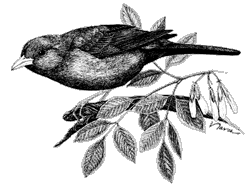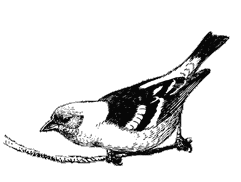Tanagers
Most tanagers are multi-colored birds of tropical forest. There are places in South America, in the foothills of the Andes, where flocks of small birds may include a rainbow palette of a dozen species of tanagers. Only a few species are found north of the Mexican border. In the Sonoran Desert they have only a marginal presence, but their bright colors make them conspicuous when they do appear.
Summer Tanagers in eastern North America inhabit oak woods, but in the west they are mostly streamside birds. Where desert rivers still have good stands of cottonwoods, Summer Tanagers are common throughout the warmer months. Since they keep to the treetops, they are not easy to see, but their crackling call notes and lazy, burry songs are familiar sounds.
 |
Western Tanagers nest only in coniferous forests of the high mountains and the north, so they might seem most unexpected in the desert. Every year during migration, however, many appear throughout the lowlands. There are days in May and again in early fall when Western Tanagers seem to be scattered all over the desert, and the striking yellow-and-black males look oddly out of place—which they are. Before winter weather sets in, they will have retreated to tropical climates with more typical tanager habitat.
—Kenn KaufmanTanagers
Representative Sonoran Desert species:
Summer Tanager (Piranga rubra)
Western Tanager (Piranga ludoviciana)
Order: Passeriformes
Family: Thraupidae
Spanish names: piranga avíspera, cardenal avíspero
Distinguishing features
Summer Tanager: Full-plumaged males are rose red; females and young are yellowish or olive-green; often mistaken for Cardinals, but lack crests (the only all-red non-crested bird to occur in tall riparian communities). Western Tanager: Adult male has a bright red head, yellow body, and black tail, back and wings; wings have white bars; female is dull green above.
Habitat
Summer Tanagers frequent streamside cottonwood and willow groves in the southwestern U.S. and open woodlands and oak groves elsewhere. The colorful Western Tanager lives in open conifer or mixed forests of the north and high mountains. During migration it may frequent any habitat, including desert and grassland.
Feeding
• Diet: Insects and small fruits.
• Behavior: Both species forage in the tops of trees where prey is taken from the foliage; insects also taken midair. Summer Tanagers may take prey from leaves while hovering; also known to raid wasp nests for larvae. Western Tanagers take frequent trips to flowers, possibly for both nectar and insects.
Life History
 |
Summer Tanager: This species is present in southern Arizona only during the summer, when it nests in willow, cottonwood, or sycamore groves in canyons up to about 5000 feet. It usually lays 4 pale bluish-green spotted eggs in a shallow cup-shaped nest of plant fibers placed on a horizontal limb of a large tree. The female incubates the eggs for 11 to 12 days and is assisted by the male in feeding the nestlings.
Western Tanager: The nest is usually placed in the fork of an outer limb
of a coniferous tree. The woven, cup-shaped nest is made of twigs, grass,
bark strips, and rootlets. Bluish-green eggs (3 to 5) with brown blotches
hatch in about 13 days. The young leave the nest about 14 days after hatching.
![]()
Feather Molt
Birds periodically molt their old feathers and replace them with new ones. The purposes of feather molt are to replace worn feathers, to change into or out of courtship plumage, or, maybe, to improve hygiene. The timing and frequency of molts are very important. Each species has its own pattern. One common pattern consists of a partial body molt before the breeding season to bring a bird into courtship color, then a complete molt of all the feathers, including flight feathers, after breeding and before migration. Feathers are usually molted in a gradual pattern, so that the bird does not lose its ability to fly or to protect its body from the elements.










